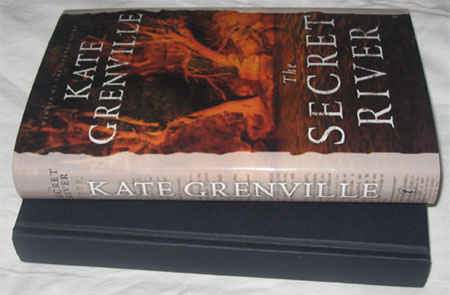
In the November 2005 issue of "Australian Book Review" (ABR), Jack Bradstreet, gentleman bookseller of this parish, wrote to the editors with a complaint. His complaint related to the new novel, The Secret River by Kate Grenville, and specifically to the lack of any identifying text on the cloth case. If you look at the photo above you will see what he is talking about: there is no text on the spine and none on the front cover. Jack, if I may call him that, had no problem with the dust-jacket, his difficulty was with the cloth cover of the book itself.
When I first read this letter I was dismissive - surely the publisher wouldn't do that I thought. What happens if the dust-jacket is ruined or lost? There is nothing to identify the book at all. Surely they wouldn't. But they did.
In the following issue of ABR (Dec 2005/Jan 2006), Michael Williams for Text Publishing (the publisher), wrote in to reply to Jack's complaint. "The absence of embossing on the spine was not a production decision, rather a design one," he wrote. "We're very proud of this book and of Chong Wengho's magnificent design; the remarkable photo of the river bank on the jacket; the spine framed by the Sydney Gazette; the austere confidence of the unmarked cover boards beneath; the beautiful endpapers of the 1819 Hawkesbury map within. We felt that this was a book of such distinction that we would break with convention."
I agree with most of what Mr Williams says here. The design of the jacket and endpapers is wonderful, but referring to the blank cover as having an "austere confidence" strikes me as artistic mumbo-jumbo. Why not refer to the tabula rasa of the cover upon which the reader may imprint their own pattern, or to the cover's nihilistic simplicity? It's referred to as a design decision, but, as we're all aware, design decisions of this sort are always about marketing or money. Generally both. Mr Williams then went on to say that he hoped Jack Bradstreet would hold on to his copy of this first edition. He thought it might be worth something one day.
Jack wasn't convinced. He's a life-long book collector and book-seller. He knows the value of an item when he sees it. "Bold and unconventional this design may be, but it is at the expense of the author and the buyer." With which I can only agree.
And as to the monetary aspect, Jack went on to say: "I shall keep the volume and attempt to maintain its condition, not as monetary investment but as a novel I certainly intend to revisit. It is also an artefact of distinctive oddity."
It will be interesting to see if the UK edition follows this design decision. I suspect not. I also suspect the second edition will fill in the blank spaces on the cloth covers. If it doesn't, it should.
[Note: the title of this posting really isn't mine. It was the title placed by the editors of ABR on Jack Bradstreet's original letter. It seems to fit.]
